The Google Pixel C Review
by Brandon Chester & Joshua Ho on January 25, 2016 8:00 AM ESTGPU Performance
Even to this day, Tegra K1 has held the crown for best GPU performance in a mobile Android device. From one point of view this is quite impressive, as it shows how NVIDIA was able to build a GPU that no other SoC vendor apart from Apple was able to beat. From another point of view, it's quite concerning to see that nobody apart from Apple values GPU performance enough to try and beat NVIDIA's chips.
Being an NVIDIA SoC, Tegra X1 is paired with a GPU designed in-house by NVIDIA. More specifically, it’s a 256 core part based on their Maxwell architecture. We’ve already seen how this GPU performs in the SHIELD Android TV, but due to being battery powered and having stricter thermal constraints, there will obviously be differences in performance between it and the Pixel C. In this case, it appears that the GPU is also running at a lower frequency than the SHIELD Android TV. While it has been estimated that the SHIELD Android TV's version has a peak GPU frequency of 1GHz, I believe the implementation used in the Pixel C has a peak GPU clock of approximately 850MHz. It’s also worth noting that the Pixel C uses the open source Nouveau kernel drivers that differ from NVIDIA’s kernel drivers on the SHIELD Android TV and SHIELD Tablet K1, and it doesn’t have full OpenGL support which has been the case with Google’s previous Tegra-powered devices as well. With all that in mind, lets dive into our standard mobile GPU test suite to evaluate the GPU performance of the Pixel C.
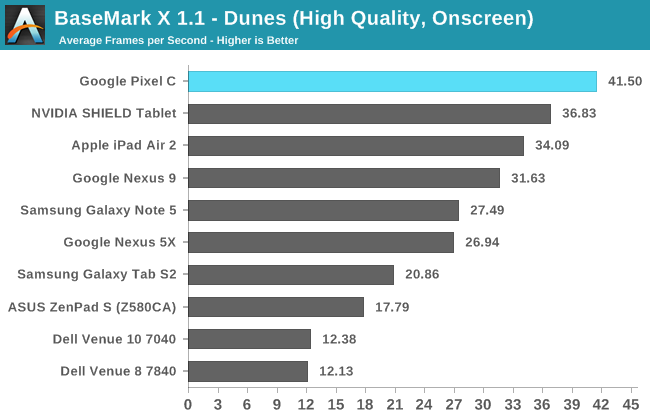
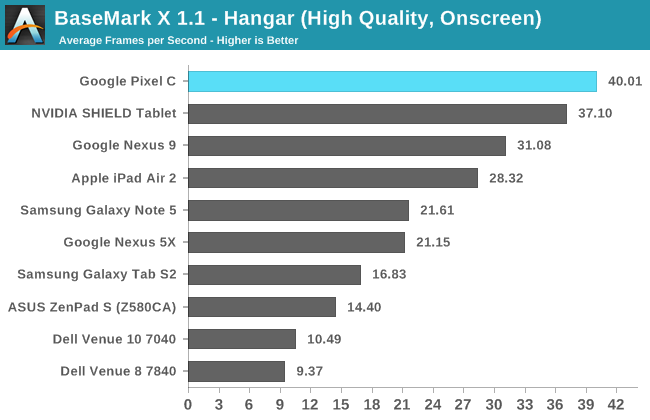
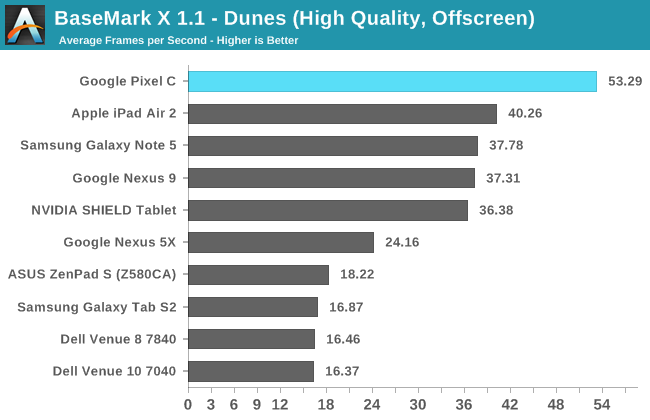

There's not a whole lot to be said about the Pixel C's performance in BaseMark X beyond saying that it's faster than any other Android device by a large margin. Even in the on screen tests, the Pixel C with its substantial resolution is still the fastest device on the charts. Absolute GPU performance as shown in the off screen tests shows a 43% performance improvement over the Tegra K1 used in the Nexus 9.
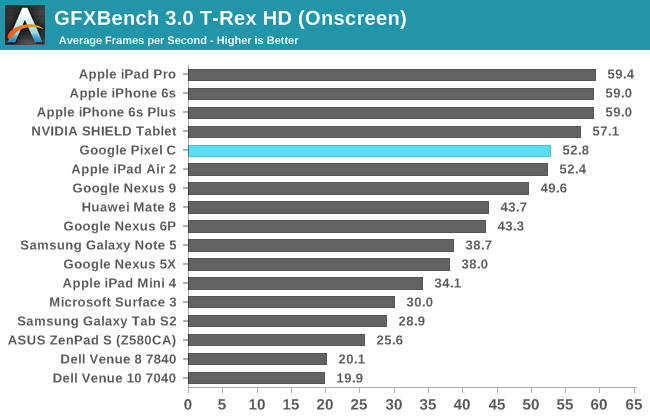
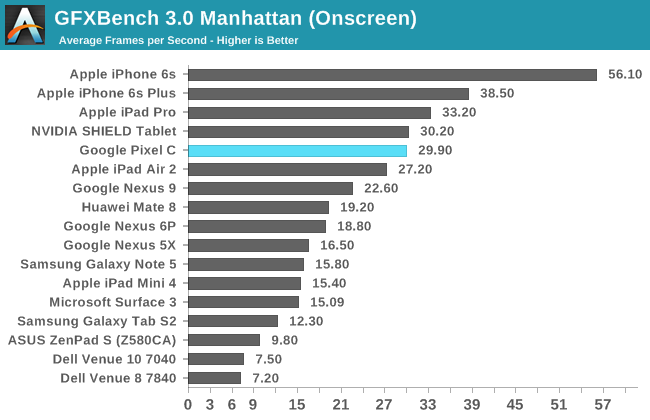
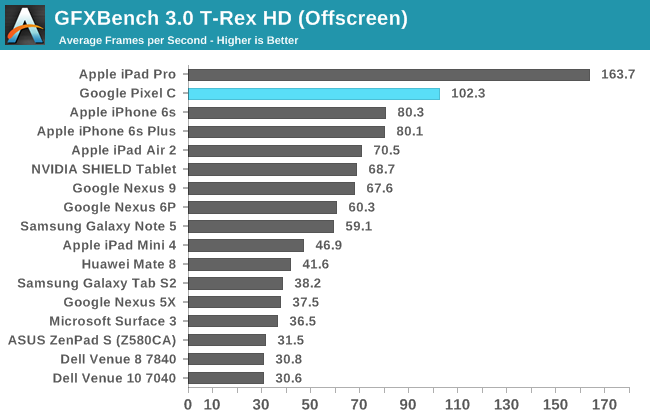
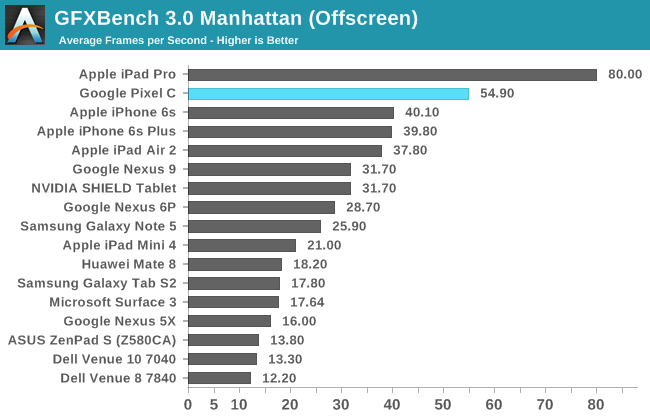
In GFXBench's T-Rex on screen test the Pixel C comes very close to hitting the Vsync limit despite its relatively high resolution. Off screen performance in both T-Rex and Manhattan is exceptional, and both tests make it clear that the Pixel C has the most powerful GPU in any mobile Android device. The gap between it and the next fastest device is quite large too, and the only tablet that can beat it is the iPad Pro with its A9X SoC.
The GPU performance of the Pixel C is unparalleled in the Android space. Not only that, but it ends up being faster than any similarly sized tablet, including the iPad Air 2 and of course the Nexus 9. It’s certainly impressive, and while I don’t mean to take away from the achievement, I can’t help but wishing that we had seen Tegra X1 come to market a bit sooner. Beating out A8X and Tegra K1 is great, but the former of those SoCs is also now well over one year old. While comparing to the iPad Pro is unfair in some respects due to the size difference, both devices do sell themselves as tablets priced for productivity, both launched at around the same, and NVIDIA’s GPU isn't as fast as the one in A9X. That being said, at $799 the iPad Pro is also significantly more expensive than the Pixel C, and relative to its price the Pixel C offers amazing GPU performance. The only concern would be if A9X shows up in some sort of regular sized iPad priced at the same level as the Pixel C. While I certainly do wish we could have seen Tegra X1 in some sort of tablet a bit earlier in the year, right now it does stand as the chip with the fastest GPU to ship in a standard size tablet, and I don’t think it will disappoint even when playing the most intensive 3D games.
Storage Performance
Something that hasn't been investigated very thoroughly in the past is smartphone storage performance. However, among high end devices this is now becoming a point of differentiation. Apple has moved to their own storage solutions that use NVMe and run over PCIe, while Samsung is pushing forward with UFS 2.0. While the Pixel C is a premium tablet, it ships with a standard eMMC storage solution. It also has Google's disk encryption enabled, which has been shown to impact storage performance in the past.
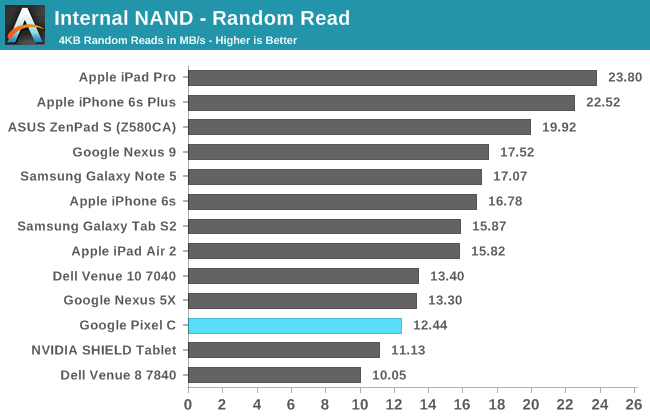

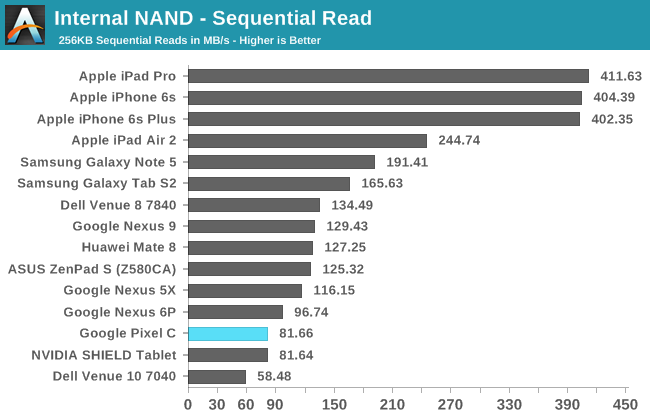
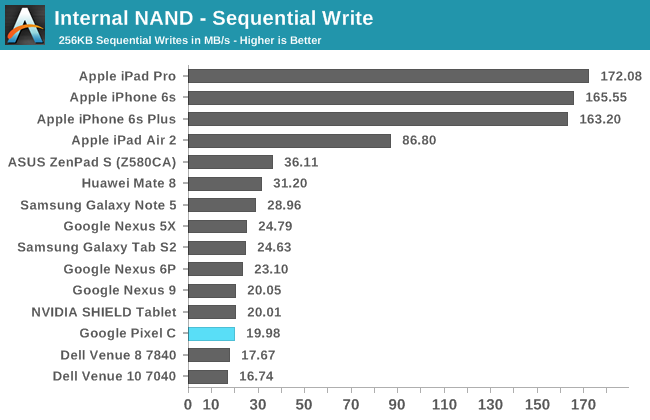
Like every Android device that Google has been involved in developing, the Pixel C doesn't fare well with our storage performance tests. Random reads and writes decent, although not competitive with new storage solutions like the SSD in the iPhone 6s and iPad Pro. Sequential speeds are simply not good at all, and definitely not competitive with what you'll get in an Apple device from the past two years or anything with an unencumbered and halfway decent eMMC or UFS storage solution. There's not much point in going over this issue again, because at this point it's clear that Google doesn't consider storage performance to be a metric worth competing on. I think it is, and I think that users end up appreciating the benefits of faster storage through quicker app installations, less loading when working with large files, among other benefits, even if they don't know what's driving those improvements behind the scenes. It's definitely something to think about when considering the Pixel C as a tablet, especially if you have a productivity focus.










122 Comments
View All Comments
Laxaa - Tuesday, January 26, 2016 - link
It seems to me like the Pixel C was released a year or two too early.versesuvius - Tuesday, January 26, 2016 - link
Adding a keyboard to an ARM device is just adding insult to injury. ARM devices are never going to be useful beyond what they were intended to be in the first instance, which is content consuming devices. Their advantage, which is size and power consumption, is also their limitation. If any company tries to sell an ARM device with a keyboard, one can be pretty sure that that company is pretty much at the end of the road. Disabling four cores of the processor on the top device from the company, while pushing a keyboard on buyers, just says it all. It says that the buyer was not going to do anything useful with it anyway, that is with this device from this particular company anyway.hMunster - Tuesday, January 26, 2016 - link
How can you appload the battery run time and lament the size and weight at the same time?10basetom - Tuesday, January 26, 2016 - link
So the final grade for the Pixel C is a C. Final grade for Android tablet ecosystem? D-Lolimaster - Tuesday, January 26, 2016 - link
How can you release a tablet without SD reader, come on.This tablet would be perfect for reading my collection comics&manga, I don't want to rely on the internetz just for reading purposes.
Demigod79 - Tuesday, January 26, 2016 - link
A couple of years ago I attached a keyboard case to a Nexus 10 and tried to use it like a laptop. It failed. Even though the Nexus 10 supported keyboard navigation and mouse input I found it difficult to anything really productive, and having a keyboard cover on it limited its functionality as a tablet. The Pixel C seems to be a modern-day rehash of my failed experiment with the Nexus 10 and I can very well imagine how using it would be (that is, very bad).The thing is, I had thought Android tablets would gradually evolve and grow, incorporating desktop features like expanded storage and windows apps. The latter was something that I particularly desired ever since using Samsung tablets that had pop-up apps. I thought this was the future and hoped Google would adopt and expand it to incorporate all apps. Frankly, I never thought tablets should have tablet versions of apps. In my opinion, running one app at a time was largely due to the limited screen space available on a phone, which obviously didn't apply to tablets. I thought the natural thing to do with a tablet was to run those phone apps in separate windows, not have bigger versions of those apps. I dreamed of the day when I would be able to run multiple Android apps at once like I did on my laptop.
I waited in vain for Google to incorporate windows apps, and then last year I got fed up and bought a Surface Pro 4 instead. It was the best decision I had ever made. Not only can the Surface Pro 4 replace my laptop (haven't touched it since) it can also replace my tablet since I can run Bluestacks (Android emulator) on it. Best of all, I can finally run Android apps in a window like I've always wanted to do. Add in the ability to run desktop applications as well as desktop games through Steam and it easily ranks as the best mobile device I've ever bought. I have given up on Microsoft for a while but it now seems to be the future (Android had the potential to be the future but Google squandered the opportunity, and now they are relegated to creating lame products like the Pixel C).
deppman - Friday, January 29, 2016 - link
I agree, although I prefer Ubuntu as my general purpose OS since it is more appropriate for my needs.Have you seen Jive's Remix OS? It's pretty much what you describe, and it's run by ex googlers. I expect Google to buy them out because the evolution is so obvious and correct. It's my guess that internal political BS is what has happened here. If they simply added windowed ART apps to chrome OS - or windowed apps and a full chrome browser build to android, they'd achieve pretty much what you described.
IMO, they are missing a wonderful opportunity to unseat MS as the primary desktop OS by not resolving this obvious elephant in the room.
Nisthar - Wednesday, January 27, 2016 - link
Hi Guys, This is a contest hosted by one of the members in my site. He needs a review on Lenovo k4 note + AntVR headset. You can view the contest http://reviewill.com/contest/2 . You may need to register to apply for the contest. The requirements for the contest would be mentioned in the contest description written by him. The winner will recieve $150.Ways to earn money in the site:
1. You can earn through referring your friends. You will get $1 for every 10 users that you refer. The referrals should be verified.
2. You can earn big money through cpa offers.
3. You can post interesting stories through quickpost.
4. You can get 100% user written custom reviews on any brands, companies, movies, etc.
Sign up: http://reviewill.com/register
Sorry if it disturbed you :)
alexlaoe - Wednesday, January 27, 2016 - link
Runs very well. Just bought one and I love the beauty behind the design.https://open.spotify.com/user/artistm/playlist/1RC...
Rc1138 - Sunday, January 31, 2016 - link
Despite my love for big tablets I can't bring myself to like this device. Making a "productivity" tablet is just too early for android. I have a really old nexus 10 and it's nand perfomance as well as overall stability(touch,wi-fi and apps) is several times better than this halfassed powerhouse. The only thing I like about Pixel C is battery perfomance(both battery life and charge time) because nexus 10's charge time equals it's web browsing time(roughly 7 hours). I can't think of a targeted group this tablet is aimed for because for the same price you can buy a really sophisticated surface 3